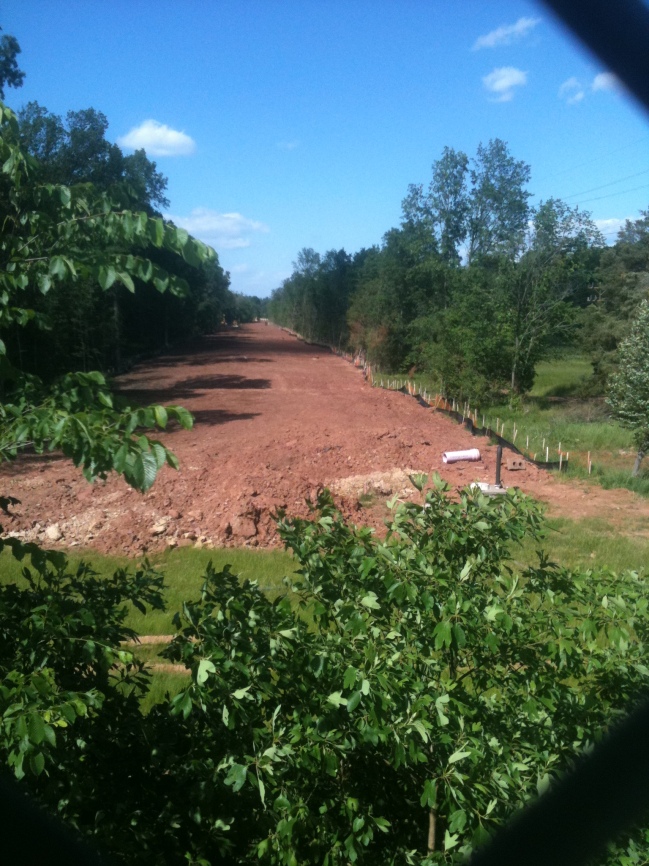This weekend, I was driving through Reston, Virginia for some errands during one of the sunny respites of an otherwise rainy week. I found that others had also chosen to make hay; in the course of several miles I observed about five landscaping crews mowing and leafblowing city and commercial property. As a stormwater engineer – and a driver – I was also quick to observe that this waste was intentionally blowing into the middle of the road.
 My mind immediately jumped to what would happen next: in the unlikely event that the surrounding sewer inlets are filtration devices (known as structural best management practices or BMPs), the imminent rainstorm is going to send all the leaves and grass right into the filter, shaving months off of its intended performance life. Filters are meant to catch and retain particulates and the occasional trash piece, not routine detritus. Given how infrequently maintenance is performed on most BMPs, the device might not even serve any purpose after a few months under such field conditions.
My mind immediately jumped to what would happen next: in the unlikely event that the surrounding sewer inlets are filtration devices (known as structural best management practices or BMPs), the imminent rainstorm is going to send all the leaves and grass right into the filter, shaving months off of its intended performance life. Filters are meant to catch and retain particulates and the occasional trash piece, not routine detritus. Given how infrequently maintenance is performed on most BMPs, the device might not even serve any purpose after a few months under such field conditions.
In the more likely event that the storm sewer system had no such BMPs, the leaves and grass will run right through the sewers, and into our natural water bodies where it will blanket stream floors. The clippings will provide more nitrogen and phosphorous than what the aquatic ecosystem was ever prepared for, and likely lead to algal blooms. Whatever was mixed with the clippings (e.g. trash, dog waste) will lead to another set of problems.
Thankfully, Reston’s storm sewers flow to giant BMPs-turned-Recreational-Benefits known as their man-made lakes. These overgrown ponds will trap and retain all of the nastiness and by the grace of insufficient interest and funding the lakes will remain off of EPA’s next 303(d) Impaired Waters List.
But in countless other areas, the clippings will run right into a Chesapeake Bay feeder stream. Multiple times per year. Without anyone thinking much about it.
When we engineers make models of watersheds and try to figure out where pollution comes from and where it gets reduced, we like to think in terms of structures. A treatment plant here, a city there, a stream in between. But when it comes to pollution, just as important as human structures are human behaviors: where we build, where we choose to live and work, how we grow our food, and how we maintain our greenspace. In changing these (while frustratingly hard to model), we truly change how we impact our environment.
It therefore falls to public officials, and an engaged public, to make the case for behavioral changes. The costs of your additional maintenance crew time are eclipsed by the benefits of a bay that can contiue to provide us recreational and economic utility for years to come – and not make swimmers sick.
Recently, the Chesapeake Bay Program announced that since 2009, the three key pollutants had decreased by anywhere from 25, 27, and 32 percent. This is certainly good news to be heralded; the Bay TMDL Phase I got stakeholders to reduce their pollution contributions. But this comes with several caveats. Pollution measures of all sorts abated between this period thanks to a crippling recession, which resulted in less construction and industrial activities overall. Some will also question the modeling methods. More importantly, stakeholders used this opportunity to identify easy, glaring problems that could be fixed simply – the proverbial “Low Hanging Fruit.” Now, with just over 10 years to go for their final deadline, the coalition will need to find ways to eliminate that final 68 to 75 percent.
With DC Metro area development continuing unabated, this is going to be a tough challenge, and I certainly expect to see stakeholders claim that it is an infeasible goal, with all reasonable measures exhausted. The fruit is too damn high.
Allow me then to pre-emptively say: Nope, you missed a few.


 As more and more eco-conscious chains and brands have moved away from disposable bags, major metropolitan areas have gone ahead and taxed or banned one-use bags outright. Trust California to be the trendsetter on this issue. Malibu has had a bag ban in effect for more than three years, and Santa Monica is now at a year and a half. Take a look at this
As more and more eco-conscious chains and brands have moved away from disposable bags, major metropolitan areas have gone ahead and taxed or banned one-use bags outright. Trust California to be the trendsetter on this issue. Malibu has had a bag ban in effect for more than three years, and Santa Monica is now at a year and a half. Take a look at this 

 My mind immediately jumped to what would happen next: in the unlikely event that the surrounding sewer inlets are filtration devices (known as structural best management practices or BMPs), the imminent rainstorm is going to send all the leaves and grass right into the filter, shaving months off of its intended performance life. Filters are meant to catch and retain particulates and the occasional trash piece, not routine detritus. Given how infrequently maintenance is performed on most BMPs, the device might not even serve any purpose after a few months under such field conditions.
My mind immediately jumped to what would happen next: in the unlikely event that the surrounding sewer inlets are filtration devices (known as structural best management practices or BMPs), the imminent rainstorm is going to send all the leaves and grass right into the filter, shaving months off of its intended performance life. Filters are meant to catch and retain particulates and the occasional trash piece, not routine detritus. Given how infrequently maintenance is performed on most BMPs, the device might not even serve any purpose after a few months under such field conditions.